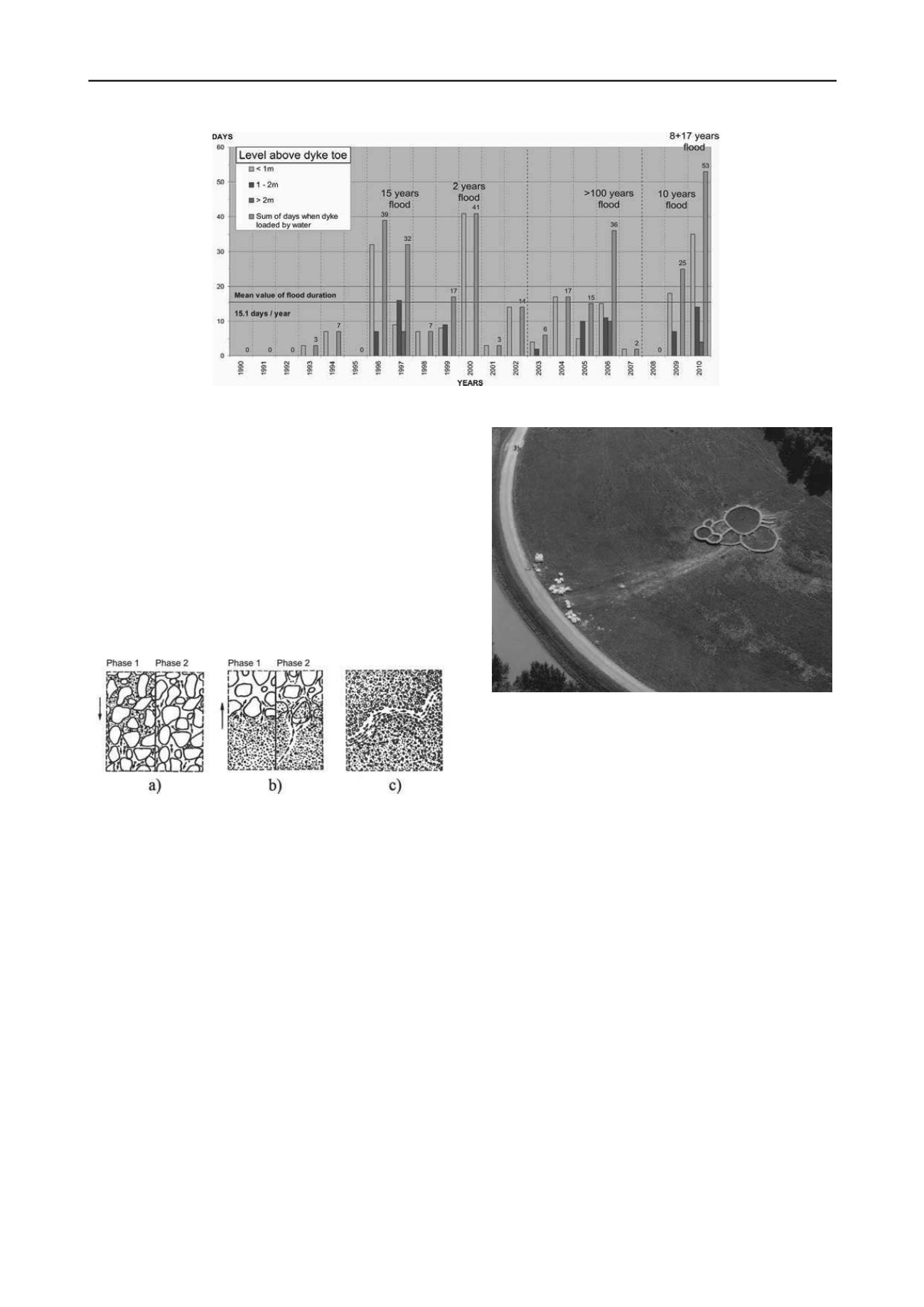
3290
Proceedings of the 18
th
International Conference on Soil Mechanics and Geotechnical Engineering, Paris 2013
Figure 1. Duration of floods along the River March dykes (Water level at Dürnkrut – Austria/Slovakia; adapted after via donau). Two floods within
three weeks in 2010.
This ‘boiling’ dominates in silty-sandy soil, and is
combined with internal erosion.
By internal erosion. Soil particles are transported within a
soil stratum or at the interface of soil strata (Fig. 2). This
may finally result in regressive erosion, leading to ground
failure of the dyke, levee or dam.
By piping. Failure by piping is a particular form of internal
erosion, where erosion begins at the surface, and then
regresses until a pipe-shaped discharge tunnel is formed.
Failure occurs as soon as the water-side end of the eroded
tunnel reaches the river bed or bottom of the reservoir.
Frequently, several tunnels develop. This process may be
induced or significantly promoted by animal activities, as
field observations over many years have revealed.
Figure 2. Hydraulic fracture of dykes or flood protection dams due to
seepage through or beneath the dyke or dam (Ziems 1967): (a) suffusion
(fine particles move into pore voids of coarse grain fractions); (b)
contact erosion at the interface of soil strata; (c) internal erosion in
steady-state flow condition.
Hydraulic failure may reach several tens of meters
away from dykes or dams, as experience has shown (Fig. 3).
This could be observed even for low flood protection
embankments with a relatively small hydraulic gradient.
Eurocode 7 (CEN 2004) states that in situations where the
pore-water pressure is hydrostatic (negligible hydraulic
gradient) it is not necessary to check other than for failure by
uplift. In the case of danger of material transport by internal
erosion, filter criteria should be used. If the filter criteria are not
satisfied, it should be verified that the critical hydraulic gradient
is well below the design value of the gradient at which soil
particles begin to move.
Experience has shown that the magnitude of the
critical hydraulic gradient where internal erosion begins is
frequently overestimated. Figure 4 summarizes the critical
values on the basis of field observations, geotechnical
measurements, literature and long-term experience for different
soils. For comparison, the conventional criterion (i
crit
= γ ‘/γ
W
),
Lane’s criterion, and the critical zones after Eurocode 7 (CEN
2004) or Chugaev (1965) respectively are also plotted in the
diagram.
Figure 3. Piping (soil boiling) far away from the dyke, and stabilizing
measures to reduce the hydraulic gradient (photo: L. Nagy).
Hydraulic failure may occur despite cut-off walls, if
they are “imperfect” walls in order to allow groundwater
communication below the dykes or levees (for environmental
reasons). Fine-grained cover layers with local “windows” and
low residual shear strength favour such failure modes.
The need of underseepage control for permanent or
temporary hydraulic loaded dams or levees is determined from
the ground profile, soil mechanical properties and hydrological
parameters. Seepage enters the permeable aquifer through the
riverbed and through cracks and inhomogeneities in the
waterside near-surface cover layer. Due to the hydraulic
gradient the groundwater flows from the riverside to the
landside of the dyke. This results into an artesian head at the
base of the landside low permeable soil layer during the
sustained flood stages. The overpressure may cause sudden
uncontrolled heave or rupture of the landward fine-grained
cover layer, especially at the dyke toe, followed by concentrated
seepage flow and erosion in this area. If the seepage through the
cover layer is possible then the hydraulic failure may occur
without heaving and only through erosion of the fine-grained
soil. The suffusion process is usually accompanied by piping of
the aquifer and causes a gradual safety reduction.
Consequently, for the underseepage of dykes or levees
safety analyses regarding hydraulic failure by erosion and/or
heaving of the cover soil layer have to be performed.
Filter protection against hydraulic failure at the
embankment toe is generally provided by the use of non-
cohesive granular material (natural soil) that fulfils adequate
design criteria for filter materials. Filter geotextiles have been


